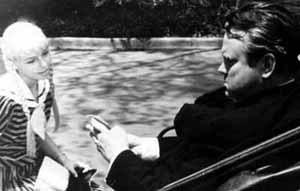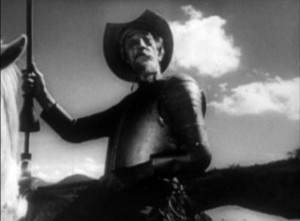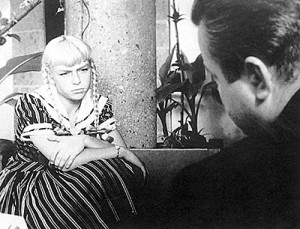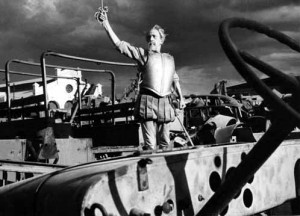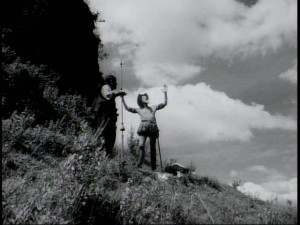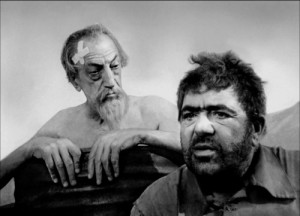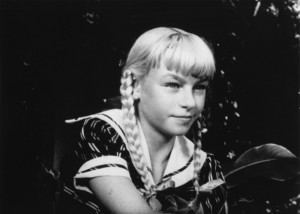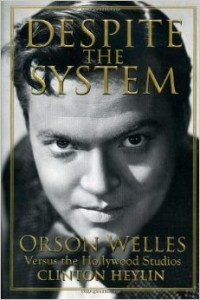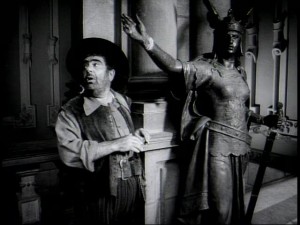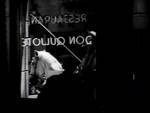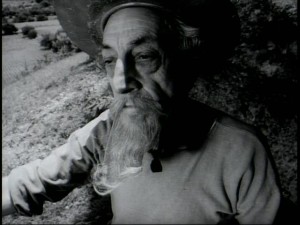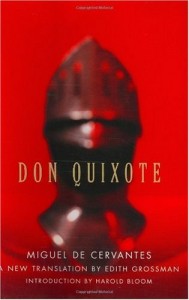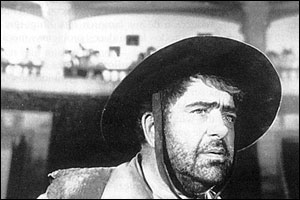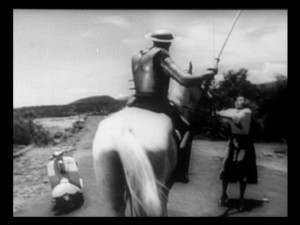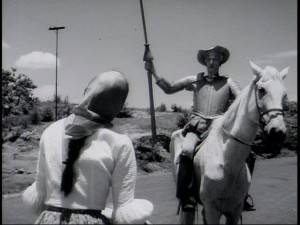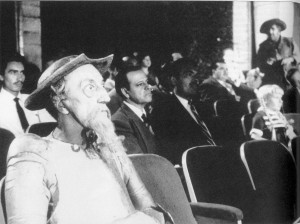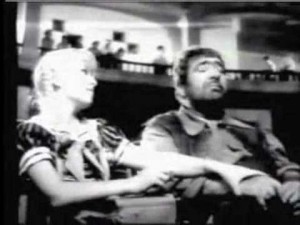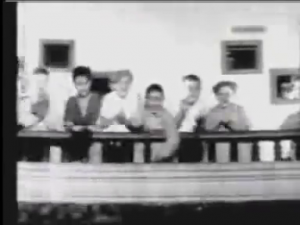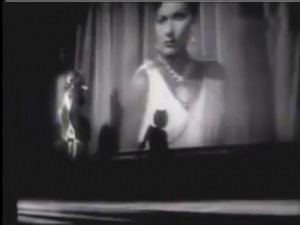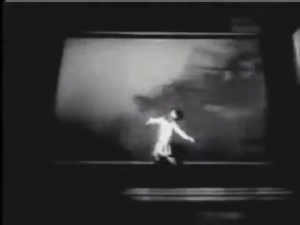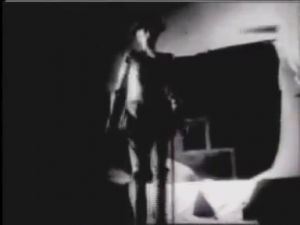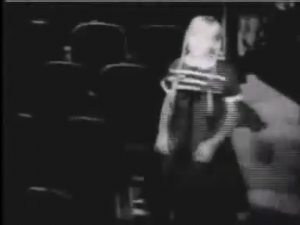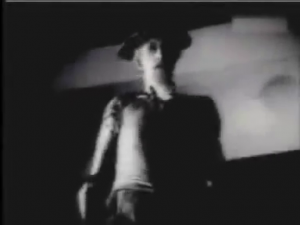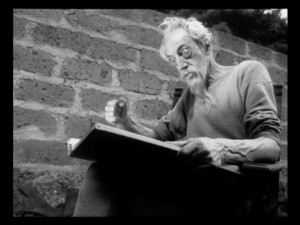This final chapter in my book Discovering Orson Welles is a lecture delivered in Valencia, Spain, on November 17, 2005, at a conference, “Don Quixote and the Cinema,” held at San Miguel de los Reyes, a convent built during the seventeenth century, making it roughly contemporary with Cervantes’s novel. The same building was used as a prison during the Franco era and functions today as a municipal library, Biblioteca Valenciana.
Given my virtually nonexistent grasp of spoken Spanish, I regretted that the event wasn’t more international; as far as I know, my paper was the only one requiring the services of a translator. The only other non-Spanish participants in the three-day event were a French man and an Italian woman, both of whom seemed to be fluent in the language.
Thanks to the generosity of the conference’s organizer, Carlos F. Heredero (the cowriter of Orson Welles en el País de Don Quijote, cited in my introduction to chapter 15, and an academic scholar and critic whose specialties include Spanish cinema and Wong Kar-wai), I was able to route my trip to Spain through Madrid before the conference and then briefly through Barcelona afterwards. In Madrid I made arrangements to spend three days at the Filmoteca Española looking at the Quixote material mentioned in chapters 19 and 20, but I was severely disappointed to discover that the ten hours I’d arranged to see mainly consisted of material from the TV series Nella Terra di Don Chisiotte and/or bits and pieces of what might be called the wreckage left by Jesus Franco’s disposal of the other footage, not including anything shot in Mexico. I’m still unclear why none of the Mexico footage could be found there, though I did learn from José Maria Prado, director of the Filmoteca, that its negative material related to Quixote is or was held in Barcelona. Today (2021), the material kept for years by Bonnani is now held by Oja Kodar.. -– J.R.
I’d like to dedicate these remarks to the memory of Henri Langlois, who in the early 1970s programmed Orson Welles’s Don Quixote as one of the first films to be shown at the New York Cinémathèque, which was never built.
When Orson Welles died in 1985, he left many of his films unfinished. Each one was unfinished in a different way and for somewhat different reasons, because, to the despair of anyone who has ever tried to market his work, no two Welles films are alike. Some of the unfinished ones aren’t even regarded as such because people other than Welles finished them in some form; I’m thinking especially of The Magnificent Ambersions and Mr. Arkadin. Some remain unfinished for reasons beyond his control — for legal and financial reasons (in the case of It’s All True and The Other Side of the Wind) or for practical reasons (in the case of The Deep, where there’s some evidence that he couldn’t persuade Jeanne Moreau to dub her lines). He couldn’t shoot more than a few fragments of The Dreamers or any of his King Lear or The Big Brass Ring or The Cradle Will Rock because he couldn’t raise the money to do so. He shot most of a short film called The Magic Show that he planned to incorporate into a larger work called Orson Welles Solo, and he shot many other fragments of pieces for the same compilation.
His Don Quixote is quite distinct from all of the above, for a number of reasons — apart from the fact that something calling itself the Don Quixote of Orson Welles was finished by someone other than Welles, who did more to mutilate and distort Welles’s material than anyone had ever done to The Magnificent Ambersons or Mr. Arkadin, much less to The Stranger, The Lady from Shanghai, or Touch of Evil.
It remained an active project for almost the last three decades of Welles’s life; it went through many versions and stages, and at least some of these versions may have come close to having been completed. The only time I met Welles, in July 1972, he maintained the film was by then virtually complete, needing only some additional sound work, including music. Maybe he was exaggerating, but maybe not. He also told me at the time with a grin, as he told many others, that whenever he did release the film he would call it When Will You Finish Don Quixote? — a title that’s inspired my own here, because the question we used to ask Welles we now have to ask ourselves, in a different way: namely, when and how can we find closure? But maybe we should be asking ourselves, instead, should we find closure? For I would argue that, more than any other Welles project, Don Quixote remained unfinished by choice — a choice that I will try to examine and to some extent defend.
There were at least four successive versions of the never-completed film: (1) Tests shot in Paris with Mischa Auer as Quixote and Akim Tamiroff as Sancho Panza. (2) Mexican footage with Patty McCormack, Tamiroff, and the substitution of Francisco Reiguera for Auer. (Unlike the various actresses cast as Desdemona in Welles’s earlier Othello, Reiguera remained his second and final Quixote.) (3) Footage shot in Italy and Spain, when Welles was still, at least initially, hoping to retain the McCormack footage by using a double for her (according to his Italy-based assistant Audrey Stainton). And (4) an essay film about Spain — specifically, about the paralysis of Spanish culture under Franco, and one that would raise the philosophical question of whether democracy would destroy the Man of La Mancha. I should add that the two versions on which Welles worked the longest were the second and third, while the first and fourth were more tentative and theoretical. My favorite is the second, and we know from Juan Luis Buñuel, who worked on it as assistant director, that Welles’s inability to finish this version because of depleted funds left him in tears on his last day of shooting.
I regret to say that I’ve been limited in my research by my meager grasp of Spanish. On the whole my two most valuable research tools, apart from the various sections and versions of the film that I’ve seen over the years, have been Stainton’s “Don Quixote: Orson Welles’ Secret” in the Autumn 1988 Sight and Sound — invaluable despite an error in her second sentence that “scraps” of Quixote were shown in Rotterdam during the mid-80s — and the Spanish resources available to me in English, especially Esteve Riambau’s “Don Quixote: The Adventures and Misadventures of an Essay in Spain”(1), as supplemented by some of Esteve’s lectures in English and by the TV documentary he made with Carlos Rodríguez and Carlos F. Heredero, Orson Welles en el país de Don Quijote (2000).
A note about Jesus Franco’s version. The disastrous misappropriation of footage from Welles’s 1964 Italian TV documentary series Nella Terra di Don Chisiotte in Franco’s edit of Quixote essentially filled the gap left by the omitted McCormack material — which provided the film’s original narrative framework but which, based on Oja Kodar’s sense of Welles’s subsequent plans for the film, she didn’t allow Franco to use.
Unfortunately, it appears that the few other Welles scholars who’ve written about his Quixote in English have ignored this issue and assumed, like Franco, that In the Land of Don Quixote and Don Quixote belong together. Even Robert Stam in his Literature through Film: Realism, Magic, and the Art of Adaptation (Oxford: Blackwell Publishing, 2004) — who also erroneously assumes both that Oja was Welles’s wife and that she worked on the film (thus eliding the production work and acting of Paola Mori) — makes this lamentable assumption and arrives at some debatable conclusions as a consequence.
And the casual imprecisions and distortions in another recent book, by Clinton Heylin, suggests that we should expect to encounter much more confusion about what the film is and was in the foreseeable future. In his Preface, Heylin first calls the 1992 Franco version a “documentary,” to be grouped with the 1993 It’s All True: Based on an Unfinished Film by Orson Welles and the 1995 Orson Welles: The One-Man Band. One sentence later, he refers to it as a “partial ‘reconstruction’ . . . painstakingly put together by Jesus Franco.”(2) Yet on the penultimate page of the same book, he writes, “Franco’s film gives very little sense of the scope of Welles’s vision, being little more than a random collection of sequences from the never-completed film.” (3)
This third description I find fairly accurate, even though it flatly contradicts the first two, which also contradict each other. How can Franco’s film be both a documentary and a reconstruction (even with the latter term modified by “partial” and placed between quotation marks), and both painstaking and random? And why, incidentally, does he give the running time as 76 minutes when it’s 40 minutes longer? The problem isn’t any ill will on Heylin’s part, such as one finds in David Thomson’s Rosebud, yet it shares with that book the task of having to fill in enormous gaps of knowledge with journalistic patter that pretends to wield some sort of authority about the subject, granting both it and us some unearned closure on the matter.
In Heylin’s final chapter, a similar strain can be felt in the way he tries to argue that Welles’s Quixote was somehow meant to be the “Hispanic equivalent” of It’s All True — not only because “the bullfighting element” was carried over from the earlier documentary, “as Welles again sought to capture something Homeric in Latin culture,” but also because Welles struggled to formulate a method that he was prepared to pursue consistently” — a generality that may apply more to Heylin’s struggles than to his. (An episode in Around the World with Orson Welles is also concerned with bullfighting, and by Heylin’s logic this might make it both a remake of It’s All True and a prequel to Don Quixote.) Then, after citing Welles’s description of his Quixote as an improvisation that would follow four weeks of rehearsals and would be “a silent film,” he notes that “the idea was subsequently transposed to an altogether different film project, Sacred Beasts.” I assume he’s thinking of Welles’s pitch for The Sacred Beasts [an early “draft” of The Other Side of the Wind] to potential investors in a Spanish bullring, briefly documented by the Maysles brothers in a short film in 1966. But he’s surely wrong in suggesting that either film was meant to be silent simply because Welles once said that parts of Quixote would be improvised in the spirit of Mack Sennett. (4)
Then, “In a subsequent reconfiguration Welles planned to place Don Quixote in modern Spain,” when this was clearly part of the original configuration. Describing the sequence of Quixote in a movie theater “slashing [the screen] to shreds,” which he admits he hasn’t seen, Heylin then goes on to speculate that “This was presumably one of Welles’s private little displays of piqué [I take it he means pique] at the critics who metaphorically slashed his work to shreds.”(5) Such a far-fetched presumption can only trivialize what may be the greatest surviving scene in Welles’s Quixote — a scene that happens to be silent only because there’s no dialogue and Welles apparently never added any sound effects.
A paragraph later, Heylin is misdescribing In the Land of Don Quixote as a Spanish rather an Italian TV series, then proposing that this project only pointed to Welles’s confusion about whether or not to make his Quixote “one extended essayage, an It’s All True take two” (6), without any clear grasp of such basics as the difference between this hack-work and the work on the feature Welles was subsidizing with it — a distinction that Franco also failed to honor — or the fact that Tamiroff could shoot in Spain while Reiguera, due to his anti-Franco past, couldn’t. Finally, there’s some muddle about McCormack and Welles speaking in the lobby (rather than in a patio) of a Mexican hotel, and this seemingly gets confused with or at least connected to another conversation between Welles and another hotel guest that was scripted in a 1943 postproduction treatment for It’s All True. But of course it’s the last refuge of every Welles analyst who can’t see a particular Welles film to try to make it seem like another Welles film, seen or unseen, when what’s most important about it is obviously its uniqueness.
***
There are many references to Miguel de Cervantes’s novel and its leading character throughout Welles’s oeuvre, including portions that precede its existence as a film project. The earliest that comes to mind is the first scene between Michael O’Hara and Elsa Bannister in the rough cut of The Lady from Shanghai (as James Naremore describes it from the cutting continuity) and the last is one of the few scenes that he managed to shoot for The Dreamers, but there are obviously quite a few others. More generally, we can make certain links between Quixote and Falstaff that relate to but also go beyond the fact that Cervantes and Shakespeare were contemporaries.
For one thing, friendship is one of the key subjects in Welles’s oeuvre — far more important and central than romantic love, I believe — and Don Quixote and Chimes at Midnight are the two most important occasions in his work when friendship crosses class barriers. The other major examples that come to mind are all basically friendships within the same class — between Charles Foster Kane and Jed Leland in Citizen Kane, between Hank Quinlan and Pete Menzies in Touch of Evil, and, among the scripted but unrealized works, between Blake Pellarin and Kim Menaker in The Big Brass Ring, between Marc Blitzstein and Orson Welles in The Cradle Will Rock, and between Pellegrina and Marcus in The Dreamers. One should add that the betrayal of friendship is also a key subject in Citizen Kane, Macbeth, Othello, Touch of Evil, and Chimes at Midnight, but not in Quixote.
Nostalgia is one of the most powerful emotions in Welles’s work, and it’s generally expressed for two distinct historical periods — for the middle ages from the vantage point of the late 16th and early 17th centuries, which we find in Chimes at Midnight and Don Quixote, and for the late 19th century from the vantage point of the 20th, which we find in Citizen Kane, The Magnificent Ambersons, Moby-Dick (which Welles adapted in one of his major stage productions), and the tales of Isak Dinesen (which formed the basis for The Immortal Story, The Dreamers, and many other Welles film projects). In Welles’s version of Quixote, which has some resemblance to a western — a quintessentially mythical view of the 19th century from the vantage point of the 20th — one might say that it’s the 20th century that winds up looking incongruous rather than the age of chivalry.
One further suggestion I’d like to make, a somewhat more debatable one, is that the most quixotic character in Welles’s oeuvre apart from Quixote himself is not a fictional character but a real person, the art forger Elmyr de Hory in F for Fake. Of course, one could argue that de Hory is a criminal while the Man of La Mancha is scrupulously honest, but I think this distinction is ultimately less important than the fact that both characters are dreamers who pretend to be other people and suffer as well as triumph as a consequence. (I should note here the cogent observation of Vladimir Nabokov, which he demonstrates at great length in his Lectures on Don Quixote, that, contrary to the way we usually view him, Quixote triumphs as often as he fails.) Welles views them both as generous and lovable innocents.
***
To understand Welles’s filmic conception of Cervantes, it’s worth citing the caveat of Esteve Riambau — that all four of the versions of Quixote planned by Welles at one time or another were in fact essays of one sort or another. But I think we can add a few other eccentric constants to Welles’s conception. One of the most curious absences to be found in all the projected versions is virtually all of the characters in the Cervantes novel, apart from Don Quixote, Sancho Panza, their respective horse and donkey, and some version of Dulcinea. We certainly see many crowds, all of them contemporary, of villagers as well as city folk, but hardly any individuals to speak of. I especially miss the curate, the barber, Quixote’s housekeeper, and his niece.
There’s a curious paradox at the heart of Cervantes’s novel involving its two principal characters. In very different ways, they might be regarded as ineffectual fools: Quixote is well-educated, intelligent, thoughtful, and articulate, but also seriously delusional: Panza has a certain amount of practical intelligence and folk wisdom, but due to his lack of education is constantly tripping over his own language and expressing himself poorly. Yet as Harold Bloom points out, in what for me is one of the most profound things anyone has ever written about the novel, “We need to hold in mind as we read Don Quixote that we cannot condescend to the Knight and Sancho, since together they know more than we do.” (It’s very tempting to include both Cervantes and Welles in this “we.”) Bloom continues, “The Knight and Sancho, as the great work closes, know exactly who they are, not so much by their adventures as through their marvelous conversations, be they quarrels or exchanges of insights.” (7)
Welles is certainly attentive to both the profound self-knowledge of these characters and the wisdom that their combined foolishness yields. Yet it’s questionable whether he maintains quite the same balance between these characters’ strengths and weaknesses that Cervantes does. Part of this difference may be attributable to the casting. Akim Tamiroff qualifies in some ways as Welles’s favorite actor as well as one of his best friends, whom he used in no less than four features, and his Sancho Panza is unquestionably Tamiroff’s earthiest performance. It’s important to add that his character’s voice (like Reiguera’s) isn’t his own but Welles’s, yet it does seem significant that, as Juan Luis Buñuel has pointed out, Welles “used a perfect Oxford accent for the voice of Don Quixote while giving Sancho Panza a particularly coarse American accent.”(8) This corresponds to the aristocratic and populist strains in Welles’s own personality, which all his films synthesize in various ways, while suggesting a fusion of American and European energies that seems far more fruitful than the Tower of Babel mixture of American and European accents heard in The Trial. In both cases, of course, he’s using English translations of novels written in other languages, but one could argue that Cervantes is far more amenable to this transformation than Kafka.
The correspondences we can trace between scenes shot by Welles and scenes in the novel are rarely precise. As nearly as I’ve been able to determine by comparing some lines of dialogue, Welles used a modified version of Samuel Putnam’s English translation, but every scene has been substantially revised. When Paola Mori, Welles’s third wife, appears briefly on a motorbike to quarrel with Quixote, she may be standing in for the six travelers with their servants in Part 1, Chapter 4 — unless she’s taking the place of the two shepherdesses or the several herdsmen who appear in Part 2, Chapter 58, which seems even less likely.
Problems of this kind in finding clear matches between Welles and Cervantes are frequent, although in some cases this may be because the original text hasn’t been examined closely enough. A surprising number of commentators have described the brilliant sequence with McCormack, Reiguera, and Tamiroff in a movie theater, in which Quixote attacks the screen, as a scene derived somehow from Quixote’s attack on several windmills in Part 1, Chapter 8, but surely this is unlikely. It seems to me that the attack of Quixote on the puppet theater on Part 2, Chapter 26 is closer to what Welles had in mind. But even if one accepts my hypothesis, precise correspondences between this scene in Cervantes and the responses to Quixote’s behavior from McCormack’s Dulcie and Tamiroff’s Sancho Panza in the audience are nowhere to be found. One might argue, in fact, that this scene and others shot by Welles that we regard as major parts of the film might more accurately be described as improvisations based on themes by Cervantes than as adaptations in any normal sense of that term.
I’m now going to show you this sequence. The only context I can provide for it is that, in the other fragments of the Mexican footage that I’ve been able to see, this silent sequence is preceded by scenes with dialogue between McCormack and Welles. Initially they’re seen seated at a table in a hotel patio, where he starts to tell her the story of the novel—with a skeptical interjection from the little girl’s mother, who has previously insisted that these characters never existed, calling down from a balcony, and a strange appearance of Sancho sneaking into the patio after Welles and McCormack have left, as if to prove the mother wrong. Then Welles and McCormack are seen more briefly (and presumably much later) in a moving carriage, where she tells him that she took Sancho in a taxi to a movie theater, which leads one to surmise that the following sequence might have figured as a flashback, possibly with her narration. [At this point I showed the sequence on video, from a copy originally recorded from late-night Italian TV.]
***
The fetishism of DVD consumers towards excluded scenes as bonuses has recently yielded a not very good scene on a French DVD of the trial involving computers, with Katina Paxinou; the sound is missing, although one can look up the dialogue in the film’s published script (unfortunately available only in French and in an English translation of that French, but not in the original English). In This Is Orson Welles, Welles maintains that he cut this scene only a day before the film opened, although Roberto Perpignani — who worked on the editing for many months as an assistant, although he received no screen credit for this work — told me in Locarno the summer before last that he never saw this scene once and that it must have been deleted early on.
The scene is clearly expendable, and one certainly can’t object to it appearing as a DVD bonus — even though a more thoughtful presentation might have added subtitles with the dialogue to this silent version. But this unresolved question is worth stressing because it suggests that a good many of Welles’s creative deliberations were in a continual state of flux, a situation that I believe was especially true of Quixote. Positing therefore any version which “conforms to Welles’s intentions” entails a necessary amount of both distortion and wishful thinking.
***
For those who remain confounded that Welles failed to arrange for a release of Don Quixote after “virtually” completing at least one version of it, I should add that I find his motivations for this explicable and even, up to a point, defensible. Although I cherish much of the Quixote material that I’ve seen (apart from the mainly egregious use of it in Jesus Franco’s cut), I’m also convinced that the film would have been critically attacked had it come out in the early 70s, and the odds of it succeeding at the box office would have been virtually nil. So Welles would have had little to gain by releasing it — while continuing to tinker with it, as he did intermittently for the remainder of his life, obviously gave him a great deal of joy. (In many respects, it was his ultimate plaything.) I’m even persuaded, based on Stainton’s article, that he actively took steps to prevent the film from being reassembled “correctly” after his death — which is perhaps less defensible (although he did legally own the film), but still understandable given Welles’s often-voiced indifference to notions of artistic immortality. “Up to a point,” he said to Kenneth Tynan in 1967, “I have to be successful in order to operate. But I think it’s corrupting to care about success; and nothing could be more vulgar than to worry about posterity.”(9) And, as far as I can tell, his main methods to prevent Don Quixote from being assembled correctly after his death included the coded and enigmatic slates he employed, described by Stainton, and, more generally, his practice of saying, in effect, to many different people at different times, “You are the only one I can trust.”
Some people have reproached Oja Kodar for the way she disposed of Quixote. My own feelings about the matter are conflicted. The best single presentation I’ve ever seen of material from the film was her own, at a Welles conference held at New York University in 1988, and without the benefit of the two screenings she gave of material that she selected herself, I wouldn’t have the same basis to criticize what Franco did to much of this material a few years later. I also know that her motives for selling the film when she did several years afterwards had a lot to do with her personal priorities — above all, her desire to keep her Croatian parents alive during the war that was being fought at the time in Bosnia- Herzegovina, Croatia, and Yugoslavia.
***
Let me cite a particular theory I have about why Welles never finished any of his projected versions of Don Quixote. I doubt that this could have been the only reason, but I do nonetheless consider it, for Welles, a compelling one: that he couldn’t bear to face the prospect of Quixote’s death at the end of the novel — the moment when the character renounces and abandons all his delusions, which is surely one of the most unbearable deaths in all of literature.
When will — and how can — we finish Orson Welles’s Don Quixote? Truthfully, we can’t finish it, though we can certainly choose whether or not we want to be finished with it. I choose not to be, because I think our imagination — which is at times difficult to distinguish from our capacity to become delusional — is always the most basic tool in Welles’s bottomless bag of tricks, and I’d hate to put it out of work.
End Notes
1. Included in the multilingual collection The Unknown Orson Welles, edited by Stefan Drössler (Filmmuseum München/Belleville Verlag, 2004), 71–76.
2. Clinton Heylin, Despite the System: Orson Welles versus the Hollywood Studios (Chicago: A Cappella, 2005), viii.
3. Ibid., 389.
4. Ibid., 333–334.
5. Ibid., 334.
6. Ibid.
7. Harold Bloom, “Introduction: Don Quixote, Sancho Panza, and Miguel de Cervantes Saavedra,” to Don Quixote by Miguel de Cervantes, translated by Edith Grossman (New York: HarperCollins, 2005), xxiv.
8. Cited and paraphrased by Esteve Riambau in his essay in The Unknown Orson Welles (see note 1), 72.
9. Orson Welles Interviews, edited by Mark W. Estrin (Jackson: University Press of Mississippi, 2002), 145.
— Paper delivered at Congreso Internacional, “El Cine y El Quijote,” organized by Carlos F. Heredero in Valencia, Spain, November 17, 2005

